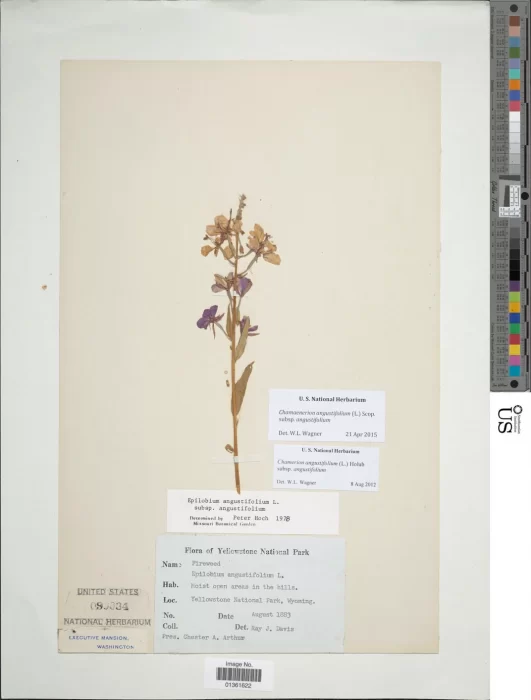2022 in Review Part 1: The National Herbarium Goes Digital
In May, the National Museum of Natural History completed a groundbreaking digitization process that brought nearly four million pressed plants online.

2022 was a busy year at the National Museum of Natural History. The museum returned to its pre-pandemic visitation hours, welcoming millions of visitors through its doors to see a host of new displays, including spectacular diamonds unearthed in America and the first Northern giant hornet nest discovered in the United States.
But much more action was taking place off exhibit, in the labyrinth of halls, labs and collection spaces at both the museum and its offsite facility in Suitland Maryland. Here, collection staff are constantly acquiring, labeling, preserving and sorting specimens that range from pressed plants and pinned butterflies to ancient fossils and massive whale bones.
Comprising more than five million specimens ranging from microscopic algae to bulky palm fronds, the National Herbarium is among the world’s largest botanical collections. And with around 120,000 type specimens — a singular specimen that represents an entire species — it’s also one of the world’s most scientifically important. And that’s before mentioning some of the iconic collectors who have contributed to this botanical bank. Among them are conservationist John Muir, evolutionary biologist Charles Darwin and American presidents like Theodore Roosevelt and Chester A. Arthur, who mounted plant specimens during his stay in the White House.

Most of the Herbarium’s plants are preserved as pressed specimens — dried plant material mounted onto large, white sheets of paper. Together, these sheets comprise a botanical library, which is stored on two floors at the museum. But making this voluminous collection accessible has proven difficult. “Not that long ago, the only way researchers could study the specimens was to come to the museum and pull them out of the cases,” said Sylvia Orli, the botany department’s digitization manager. “We had this amazing collection of specimens that was unused because only a few people could actually access it.”

With 3.8 million herbarium sheets waiting to be scanned, the standard mode of digitizing — placing sheets below a camera and punching in locality information into a database by hand — proved daunting. It took the museum decades to image and catalog just the type specimens, a fraction of the sprawling collection.In 2015, Orli and her colleagues teamed up with the Smithsonian Digitization Program Office to kick the project into overdrive. They also partnered with the Dutch digitization company Picturae to install a conveyor belt to scan the specimen sheets, streamlining the onerous process. Like groceries being scanned at the register, the whirring conveyor belt brought a new herbarium sheet below a high-speed camera every six seconds. The camera snapped images of the specimens and the various labels printed on each sheet were transcribed from the scans. Where a couple hundred sheets once took days to digitize, Orli and the digitization team could now scan between three to four thousand sheets a day on the conveyor belt.

This past May, the final herbarium sheets made their way across the conveyor belt, making the National Herbarium the first fully digitized botanical collection in the country. The team celebrated with a sheet cake decorated with the edible image of one such herbarium sheet. They weren’t the only ones celebrating — the accomplishment garnered plenty of buzz among botanists online and the international art magazine Apollo even shortlisted the effort as one of its digital innovations of the year.

The new images are not only available to professional botanists. Each of the 3.8 million sheets, which are now marked with a barcode sticker, are publicly accessible online, making one of the world’s premier plant collections available to anyone with an appreciation for the floral world.
What I really enjoy is not the specimens we already knew about, but the ones we find by accident.
Sylvia Orli, Botany Department’s Digitization Manager
The digitization process also revealed information about the collection that had been overlooked for decades. In total, 80,000 new taxa were added to the botany department’s database, rounding out the full breadth of the collection for the first time.

It also added yet another historical figure to the department’s star-studded list of collectors. As she was pouring through the transcriptions, Orli repeatedly came across the name “J. Adamson” attached to moss specimens collected in Africa during the 1940s. She instantly realized that they were procured by the naturalist and author Joy Adamson, whose experience raising a lion cub named Elsa became the basis of the award-winning film, “Born Free.”
“When I was a kid, I was a huge fan of Joy Adamson. I read all of her books and I wanted to go to Africa and be her,” Orli said. She now keeps one of Adamson’s moss specimens on her desk. “I have a little piece of Joy Adamson, something she actually touched.”

Jack Tamisiea is a Science Communications Assistant at the Smithsonian’s National Museum of Natural History. In addition to covering all things natural history for the museum’s blog, Smithsonian Voices, he tracks media coverage and coordinates filming activities for the museum’s Office of Communications and Public Affairs. Jack is currently completing his master’s in science writing at Johns Hopkins University. In his free time, he loves exploring the outdoors with a notebook and camera. You can read more of Jack’s work at https://jacktamisiea.com.
This article was originally published by the Smithsonian magazine blog, Smithsonian Voices.Copyright 2022 Smithsonian Institution. Reprinted with permission from Smithsonian Enterprises. All rights reserved. Reproduction in any medium is strictly prohibited without permission from Smithsonian Institution.
Posted: 9 January 2023
-
Categories:
Feature Stories , Natural History Museum , Science and Nature







